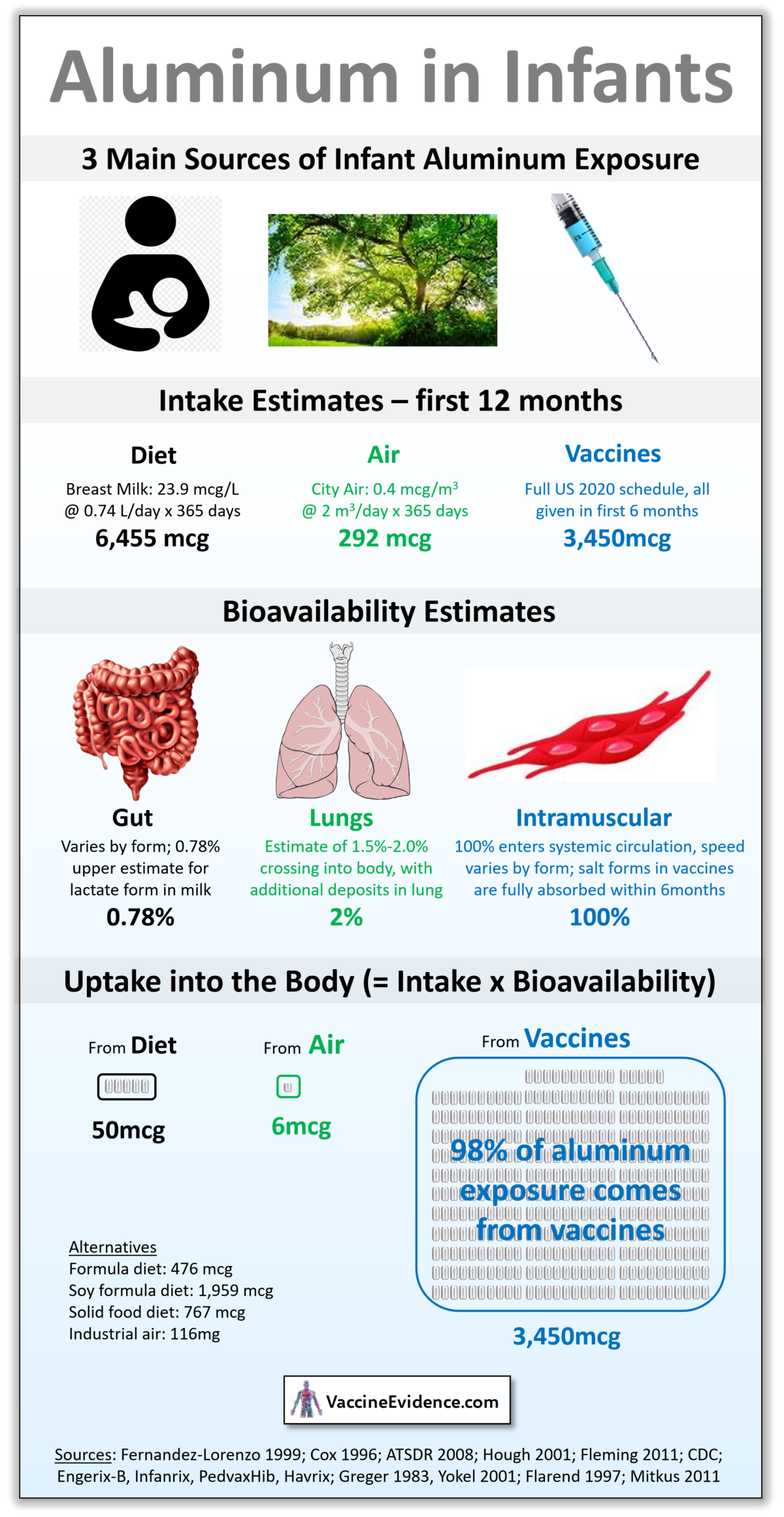This infographic demonstrates that the majority of exposure to aluminum in infants comes from vaccines.
Children fully vaccinated using the CDC schedule for the first 6 months will receive 3,450mcg of aluminum into the blood from those vaccines, as the aluminum salts used as vaccine adjuvants slowly dissolve at the intramuscular injection site and enter the bloodstream. This process takes no more than 6 months, so 100% will have been absorbed by 1 year of age.
Breast milk only contains an average of 23.9 mcg/L, and infants drink an average of 0.74 L/day, for a total dietary intake of 6,455mcg of aluminum in the first 12 months. Most of this will be defecated out, but up to 0.78% could leak across the gut lining and enter the bloodstream. This would amount to 50mcg of aluminum over the year. Formula milk contains an average of 226 mcg/L and soy formula can contain up to 930 mcg/L. With the same amount drunk and same gut bioavailability, this would be 476mcg and 1959mcg respectively entering the gut. Infants on a semi-solid food diet will be getting an average of 767mcg. There is no diet that exposes infants to more aluminum through the gut than they are from vaccines.
The third biggest normal exposure is air, but the amounts here are insignificant. Multiplying average tidal volume by average respiratory rate results in 730 m3 of air being breathed by an infant by 1 year of age. Normal city air has around 0.4 mcg/m3 of aluminum, resulting in an intake of 292mcg. Lung bioavailability has been estimated at 2%, so only 6mcg of aluminum enters the bloodstream through the lungs during infancy. Even in a city with high pollution or industrial air, with up to 8 mcg/m3 of aluminum, that uptake figure only reaches 116mcg. Infant exposure to aluminum via the air is insignificant.
Sources for all these figures are listed and linked below.
Sources:
- Fernandez-Lorenzo 1999: https://pubmed.ncbi.nlm.nih.gov/10067727/
- Cox 1996: https://pubmed.ncbi.nlm.nih.gov/8960706/
- ATSDR 2008: https://www.atsdr.cdc.gov/toxprofiles/tp22.pdf
- Hough 2001: https://b-ok.cc/book/875055/b30986
- Fleming 2011: https://www.ncbi.nlm.nih.gov/pmc/articles/PMC3789232/
- CDC: https://www.cdc.gov/vaccines/schedules/hcp/imz/child-adolescent.html
- Insert Engerix-B: https://www.gsksource.com/pharma/content/dam/GlaxoSmithKline/US/en/Prescribing_Information/Engerix-B/pdf/ENGERIX-B.PDF
- Insert Infanrix: https://www.gsksource.com/pharma/content/dam/GlaxoSmithKline/US/en/Prescribing_Information/Infanrix/pdf/INFANRIX.PDF
- Insert PedvaxHib: https://www.merck.com/product/usa/pi_circulars/p/pedvax_hib/pedvax_pi.pdf
- Insert Havrix: https://www.gsksource.com/pharma/content/dam/GlaxoSmithKline/US/en/Prescribing_Information/Havrix/pdf/HAVRIX.PDF
- Greger 1983: https://pubmed.ncbi.nlm.nih.gov/6684629/
- Yokel 2001: https://pubmed.ncbi.nlm.nih.gov/11322172/
- Flarend 1997: https://pubmed.ncbi.nlm.nih.gov/9302736/
- Mitkus 2011: https://pubmed.ncbi.nlm.nih.gov/22001122/

